46 Fruits That Start with D Facts & Pictures

Most people can name only a few fruits that start with the letter “D.”
You might be surprised to learn how many delicious options actually exist worldwide.
The letter “D” delivers an impressive variety of fruits from different continents and climates.
These fruits range from common grocery store finds to exotic tropical delights.
Many of these “D” fruits offer unique flavors, textures, and remarkable nutritional benefits.
Some are sweet and juicy, while others provide tangy or distinctly tropical tastes.
Learning about these diverse fruits can expand your culinary knowledge and dietary choices.
Each fruit brings its own distinctive characteristics and cultural significance to explore.
Without any further ado, let’s start exploring this delightful collection.
1. Durian

Durian is a large, spiky fruit known for its strong odour and creamy, custard-like flesh. It is highly prized in Southeast Asian cuisine.
- Place of Origin: Southeast Asia
- Scientific Name: Durio zibethinus
- Famous Alternative Names: King of Fruits
Nutritional Content per 100 grams:
| Nutrient | Amount |
|---|---|
| Calories | 147 |
| Fat | 5.3 g |
| Carbohydrates | 27.1 g |
| Protein | 1.5 g |
| Fibre | 3.8 g |
Health Benefits:
- Rich in Fibre: Supports digestive health.
- Antioxidants: Helps protect cells from damage.
- High Energy: Provides a good amount of energy due to its carbohydrate content.
2. Dewberry

Dewberries are small, blue-black berries with a sweet and tart flavour. They are often used in pies, jams, and desserts.
- Place of Origin: Europe
- Scientific Name: Rubus caesius
- Famous Alternative Names: Field Dewberry
Nutritional Content per 100 grams:
| Nutrient | Amount |
|---|---|
| Calories | 43 |
| Fat | 0.5 g |
| Carbohydrates | 9.6 g |
| Protein | 1.0 g |
| Fibre | 5.3 g |
Health Benefits:
- High Fibre: Aids in digestion.
- Vitamins and Minerals: Provides essential nutrients.
- Low Calorie: Good for weight management.
3. Desert Fig

Desert Figs are small, sweet fruits that grow in arid regions. They are often dried and used in baking or as a snack.
- Place of Origin: Middle East
- Scientific Name: Ficus palmata
- Famous Alternative Names: Wild Fig
Nutritional Content per 100 grams:
| Nutrient | Amount |
|---|---|
| Calories | 74 |
| Fat | 0.3 g |
| Carbohydrates | 19.2 g |
| Protein | 0.8 g |
| Fibre | 2.9 g |
Health Benefits:
- Rich in Fibre: Supports healthy digestion.
- Natural Sugars: Provides a quick energy boost.
- Vitamins: Contains vitamins A and K.
4. Damson

Damsons are small, tart plums that are often used in jams and jellies. They have a deep purple skin and yellow-green flesh.
- Place of Origin: Europe
- Scientific Name: Prunus domestica subsp. insititia
- Famous Alternative Names: Damascene
Nutritional Content per 100 grams:
| Nutrient | Amount |
|---|---|
| Calories | 46 |
| Fat | 0.1 g |
| Carbohydrates | 11.4 g |
| Protein | 0.7 g |
| Fibre | 1.4 g |
Health Benefits:
- Rich in Vitamin C: Boosts immune system.
- Antioxidants: Protects against cell damage.
- Low Calorie: Good for weight control.
5. Dragon Fruit

Dragon Fruit is a vibrant, pink fruit with white or red flesh speckled with tiny black seeds. It has a mild, sweet taste.
- Place of Origin: Central America
- Scientific Name: Hylocereus undatus
- Famous Alternative Names: Pitaya
Nutritional Content per 100 grams:
| Nutrient | Amount |
|---|---|
| Calories | 50 |
| Fat | 0.3 g |
| Carbohydrates | 11.0 g |
| Protein | 1.1 g |
| Fibre | 3.0 g |
Health Benefits:
- Rich in Fibre: Promotes digestive health.
- Vitamin C: Enhances immune function.
- Low Calorie: Suitable for weight management.
6. Date Plum

Date Plums are small, sweet fruits that are often dried and eaten as a snack or used in desserts. They have a rich, honey-like flavour.
- Place of Origin: Asia
- Scientific Name: Diospyros lotus
- Famous Alternative Names: Lotus Persimmon
Nutritional Content per 100 grams:
| Nutrient | Amount |
|---|---|
| Calories | 81 |
| Fat | 0.1 g |
| Carbohydrates | 21.0 g |
| Protein | 0.8 g |
| Fibre | 3.6 g |
Health Benefits:
- High Fibre: Aids in digestion.
- Antioxidants: Helps protect cells from damage.
- Vitamins: Rich in vitamins A and C.
7. Decaisnea

Decaisnea, also known as Blue Bean, is a unique fruit with a gelatinous texture and a mildly sweet taste. It is often eaten fresh.
- Place of Origin: Himalayas
- Scientific Name: Decaisnea insignis
- Famous Alternative Names: Dead Man’s Fingers
Nutritional Content per 100 grams:
| Nutrient | Amount |
|---|---|
| Calories | 45 |
| Fat | 0.2 g |
| Carbohydrates | 10.0 g |
| Protein | 0.9 g |
| Fibre | 2.0 g |
Health Benefits:
- Rich in Fibre: Supports digestive health.
- Low Calorie: Good for weight management.
- Vitamins: Contains vitamin C.
8. Dracontomelon

Dracontomelon, also known as Dragon’s Eye, is a tropical fruit with a tart and tangy flavour. It is used in various Asian cuisines.
- Place of Origin: Southeast Asia
- Scientific Name: Dracontomelon dao
- Famous Alternative Names: Nam Nam
Nutritional Content per 100 grams:
| Nutrient | Amount |
|---|---|
| Calories | 62 |
| Fat | 0.4 g |
| Carbohydrates | 14.8 g |
| Protein | 1.2 g |
| Fibre | 2.4 g |
Health Benefits:
- Rich in Fibre: Promotes healthy digestion.
- Antioxidants: Protects cells from damage.
- Vitamins: Contains vitamin C.
9. Desert Lime

Desert Lime is a small, green citrus fruit with a strong, tangy flavour. It is often used in sauces, preserves, and drinks.
- Place of Origin: Australia
- Scientific Name: Citrus glauca
- Famous Alternative Names: Australian Desert Lime
Nutritional Content per 100 grams:
| Nutrient | Amount |
|---|---|
| Calories | 30 |
| Fat | 0.1 g |
| Carbohydrates | 7.7 g |
| Protein | 0.7 g |
| Fibre | 2.8 g |
Health Benefits:
- Rich in Vitamin C: Boosts immune system.
- Antioxidants: Protects cells from damage.
- Low Calorie: Suitable for weight management.
10. Dangle Berry

Dangle Berry is a small, sweet berry that grows in clusters. It is often used in jams, jellies, and desserts.
- Place of Origin: North America
- Scientific Name: Gaylussacia frondosa
- Famous Alternative Names: Blue Huckleberry
Nutritional Content per 100 grams:
| Nutrient | Amount |
|---|---|
| Calories | 44 |
| Fat | 0.3 g |
| Carbohydrates | 11.5 g |
| Protein | 0.9 g |
| Fibre | 3.6 g |
Health Benefits:
- High Fibre: Aids in digestion.
- Antioxidants: Protects cells from damage.
- Vitamins: Rich in vitamins A and C.
11. Desert Cherry

With its glossy red skin and tart-sweet pulp, this small stone fruit is prized in arid regions for jams, sauces, and even wines.
Its firm texture and vibrant color also make it a striking garnish or inclusion in baked goods.
- Place of Origin: Australia
- Scientific Name: Capparis mitchellii
- Famous Alternative Names: Western Wild Cherry, Native Cherry
Nutritional Content per 100 grams:
| Nutrient | Amount |
|---|---|
| Calories | 59 |
| Fat | 0.4 g |
| Carbohydrates | 13.0 g |
| Protein | 1.0 g |
Health Benefits:
- Rich in dietary fibre, supporting smooth digestion
- Good source of antioxidants, offering protection against oxidative stress
- Low in fat, making it a light snack option
- Contains essential vitamins, contributing to overall wellness
12. Date

Dates are sweet, chewy fruits that grow in clusters on date palm trees. They are often eaten dried or used in desserts.
- Place of Origin: Middle East
- Scientific Name: Phoenix dactylifera
- Famous Alternative Names: Date Palm Fruit
Nutritional Content per 100 grams:
| Nutrient | Amount |
|---|---|
| Calories | 282 |
| Fat | 0.4 g |
| Carbohydrates | 75.0 g |
| Protein | 2.5 g |
| Fibre | 8.0 g |
Health Benefits:
- High Fibre: Aids in digestion.
- Natural Sugars: Provides a quick energy boost.
- Vitamins: Rich in vitamins A and K.
13. Darling Plum

Darling Plums are small, purple fruits with a sweet and tart flavour. They are often used in jams, jellies, and desserts.
- Place of Origin: Caribbean
- Scientific Name: Reynosia septentrionalis
- Famous Alternative Names: Jamaica Darling Plum
Nutritional Content per 100 grams:
| Nutrient | Amount |
|---|---|
| Calories | 41 |
| Fat | 0.2 g |
| Carbohydrates | 10.2 g |
| Protein | 0.8 g |
| Fibre | 2.6 g |
Health Benefits:
- Rich in Fibre: Supports digestive health.
- Antioxidants: Helps protect cells from damage.
- Vitamins: Contains vitamins A and C.
14. Desert Quandong

Desert Quandong is a bright red fruit with a tart flavour. It is often used in sauces, jams, and desserts in Australian cuisine.
- Place of Origin: Australia
- Scientific Name: Santalum acuminatum
- Famous Alternative Names: Native Peach
Nutritional Content per 100 grams:
| Nutrient | Amount |
|---|---|
| Calories | 62 |
| Fat | 0.3 g |
| Carbohydrates | 13.5 g |
| Protein | 1.1 g |
| Fibre | 6.1 g |
Health Benefits:
- High Fibre: Aids in digestion.
- Antioxidants: Protects cells from damage.
- Vitamins: Rich in vitamins C and E.
15. Davidson’s Plum
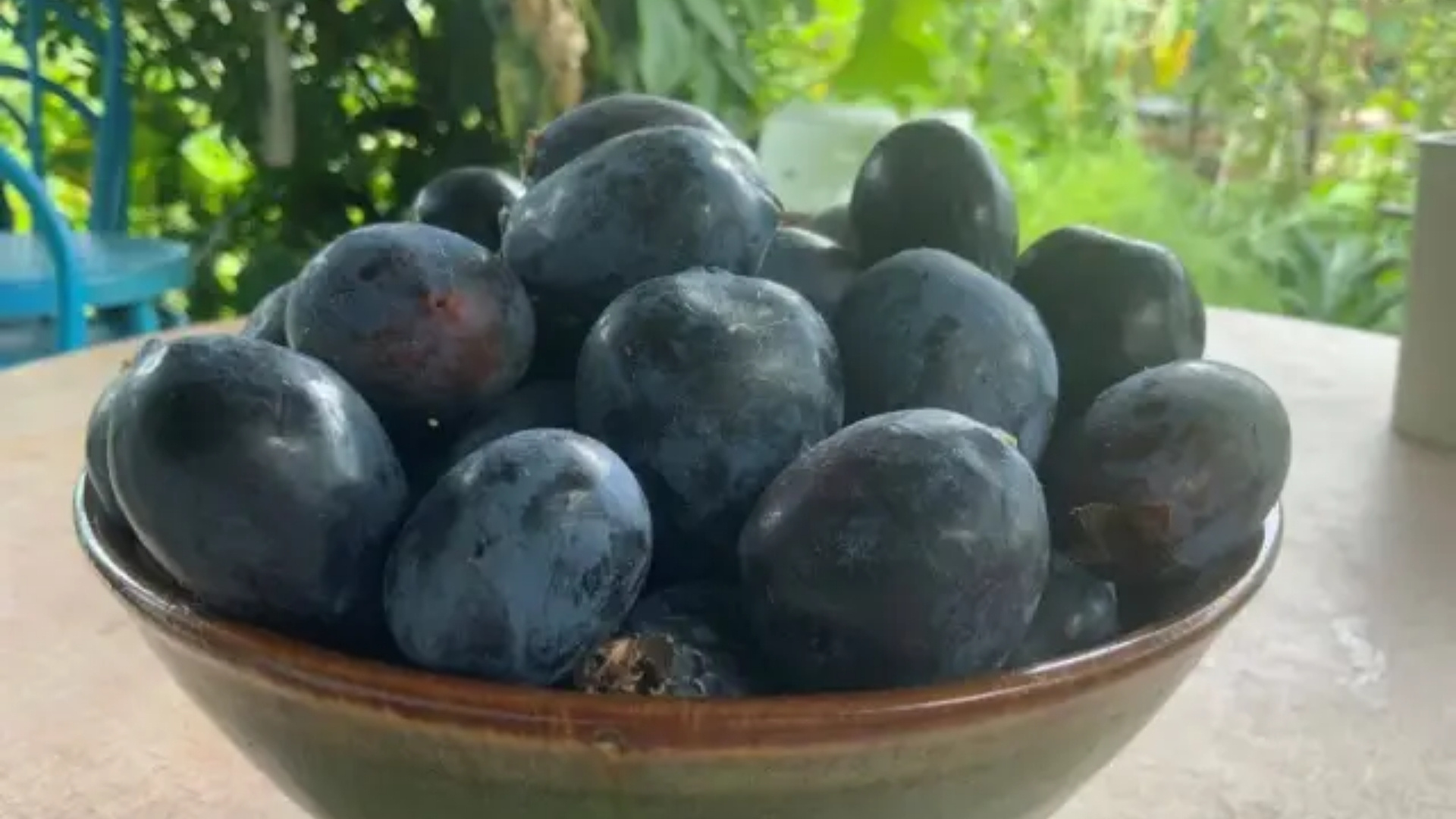
Davidson’s Plum is a dark purple fruit with a tart flavour. It is often used in jams, sauces, and desserts in Australian cuisine.
- Place of Origin: Australia
- Scientific Name: Davidsonia spp.
- Famous Alternative Names: Queensland Plum
Nutritional Content per 100 grams:
| Nutrient | Amount |
|---|---|
| Calories | 45 |
| Fat | 0.1 g |
| Carbohydrates | 10.2 g |
| Protein | 0.9 g |
| Fibre | 3.5 g |
Health Benefits:
- Rich in Fibre: Supports digestive health.
- Antioxidants: Helps protect cells from damage.
- Vitamins: Contains vitamins C and E.
16. Discovery Apple

Discovery Apple is a small, red apple with a sweet-tart flavour. It is often eaten fresh or used in cooking and baking.
- Place of Origin: England
- Scientific Name: Malus domestica
- Famous Alternative Names: Early Worcester
Nutritional Content per 100 grams:
| Nutrient | Amount |
|---|---|
| Calories | 52 |
| Fat | 0.2 g |
| Carbohydrates | 14.0 g |
| Protein | 0.3 g |
| Fibre | 2.4 g |
Health Benefits:
- Rich in Fibre: Supports digestive health.
- Antioxidants: Helps protect cells from damage.
- Vitamins: Contains vitamins A and C.
17. Duku Fruit

Duku Fruit is a small, round fruit with a sweet and tangy flavour. It is often eaten fresh or used in desserts.
- Place of Origin: Southeast Asia
- Scientific Name: Lansium domesticum
- Famous Alternative Names: Langsat
Nutritional Content per 100 grams:
| Nutrient | Amount |
|---|---|
| Calories | 60 |
| Fat | 0.2 g |
| Carbohydrates | 15.2 g |
| Protein | 0.8 g |
| Fibre | 1.0 g |
Health Benefits:
- Rich in Fibre: Aids in digestion.
- Vitamins: Contains vitamins B and C.
- Antioxidants: Protects cells from damage.
18. Double Coconut
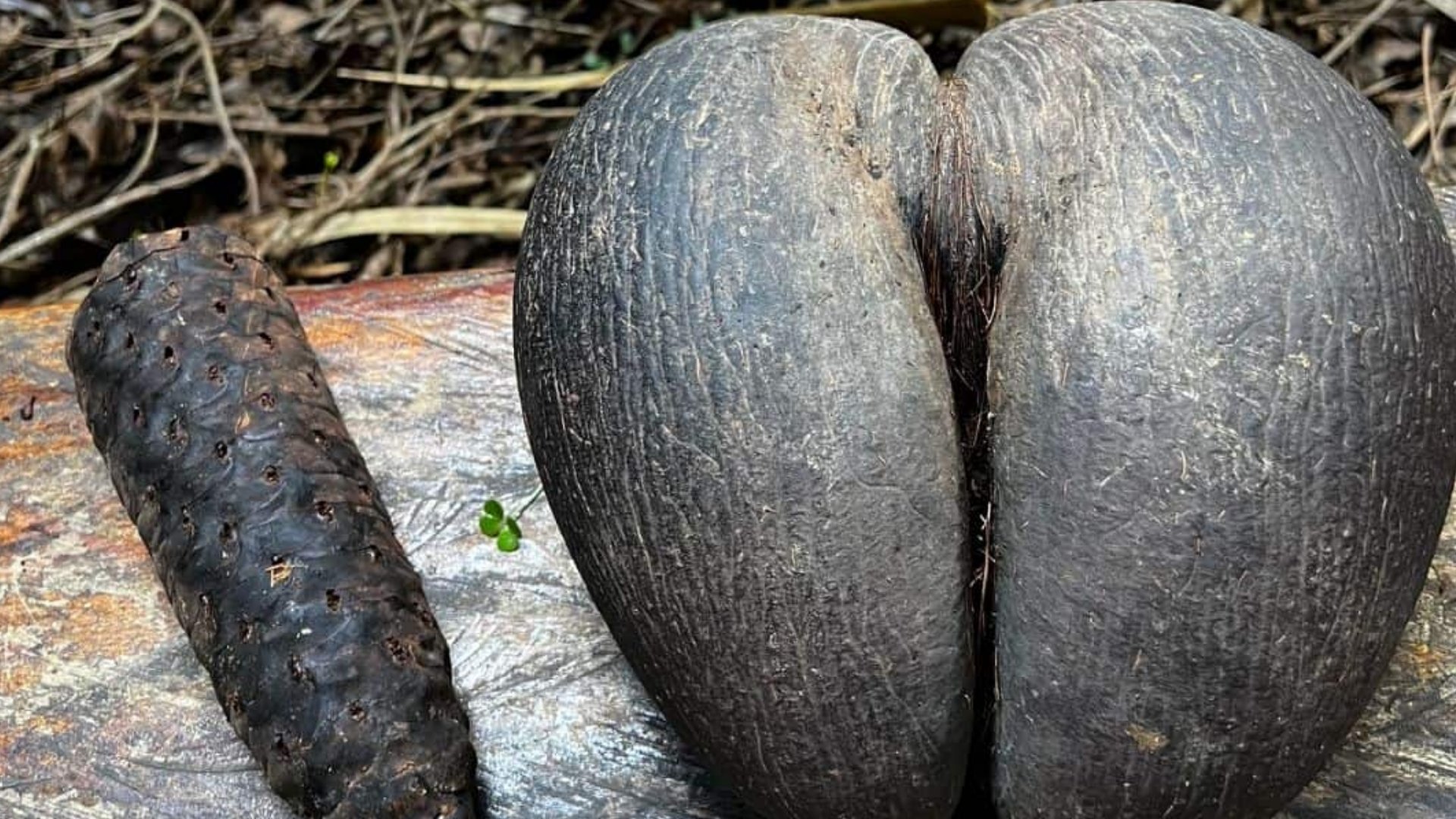
Double Coconut, also known as Coco de Mer, is a large fruit with a nutty flavour. It is often used in desserts and culinary dishes.
- Place of Origin: Seychelles
- Scientific Name: Lodoicea maldivica
- Famous Alternative Names: Coco de Mer
Nutritional Content per 100 grams:
| Nutrient | Amount |
|---|---|
| Calories | 354 |
| Fat | 35.0 g |
| Carbohydrates | 9.0 g |
| Protein | 3.0 g |
| Fibre | 5.0 g |
Health Benefits:
- High Energy: Provides a good amount of calories.
- Rich in Fibre: Supports digestive health.
- Healthy Fats: Contains beneficial fats for heart health.
19. Dabai Fruit

Dabai Fruit is a small, black fruit with a creamy texture and a rich, nutty flavour. It is often eaten fresh or used in cooking.
- Place of Origin: Borneo
- Scientific Name: Canarium odontophyllum
- Famous Alternative Names: Black Olive
Nutritional Content per 100 grams:
| Nutrient | Amount |
|---|---|
| Calories | 80 |
| Fat | 6.0 g |
| Carbohydrates | 7.0 g |
| Protein | 1.0 g |
| Fibre | 2.5 g |
Health Benefits:
- Rich in Fibre: Supports digestive health.
- Healthy Fats: Good for heart health.
- Antioxidants: Protects cells from damage.
20. Desert Banana

Desert Banana is a small, sweet banana that grows in arid regions. It is often eaten fresh or used in desserts.
- Place of Origin: Australia
- Scientific Name: Musa acuminata
- Famous Alternative Names: Native Banana
Nutritional Content per 100 grams:
| Nutrient | Amount |
|---|---|
| Calories | 89 |
| Fat | 0.3 g |
| Carbohydrates | 22.8 g |
| Protein | 1.1 g |
| Fibre | 2.6 g |
Health Benefits:
- High Fibre: Aids in digestion.
- Vitamins: Contains vitamins B6 and C.
- Potassium: Supports heart health.
21. Desert King Fig

Desert King Fig is a green-skinned fig with sweet, amber flesh. It is often eaten fresh or used in desserts and preserves.
- Place of Origin: United States
- Scientific Name: Ficus carica
- Famous Alternative Names: King Fig
Nutritional Content per 100 grams:
| Nutrient | Amount |
|---|---|
| Calories | 74 |
| Fat | 0.3 g |
| Carbohydrates | 19.2 g |
| Protein | 0.8 g |
| Fibre | 2.9 g |
Health Benefits:
- Rich in Fibre: Supports healthy digestion.
- Natural Sugars: Provides a quick energy boost.
- Vitamins: Contains vitamins A and K.
22. Dekopon
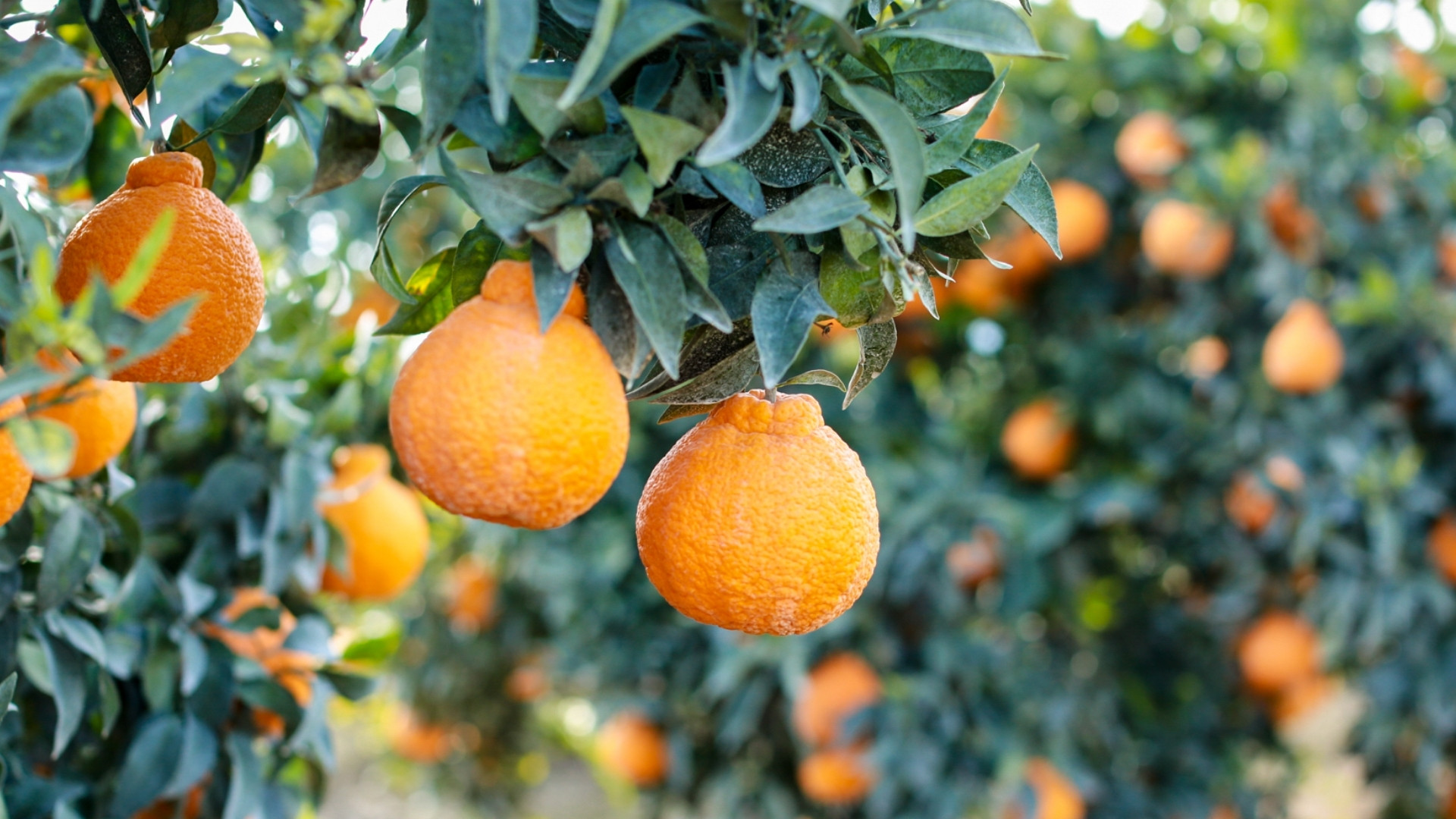
Dekopon is a large, seedless citrus fruit with a sweet and tangy flavour. It is often eaten fresh or used in desserts.
- Place of Origin: Japan
- Scientific Name: Citrus reticulata
- Famous Alternative Names: Shiranui
Nutritional Content per 100 grams:
| Nutrient | Amount |
|---|---|
| Calories | 53 |
| Fat | 0.2 g |
| Carbohydrates | 13.3 g |
| Protein | 0.8 g |
| Fibre | 1.8 g |
Health Benefits:
- Rich in Vitamin C: Boosts immune system.
- Antioxidants: Protects cells from damage.
- Low Calorie: Suitable for weight management.
23. Dodder-Laurel

Dodder-Laurel is a parasitic plant that produces small, edible berries. The berries have a sweet and tangy flavour.
- Place of Origin: Africa
- Scientific Name: Cassytha filiformis
- Famous Alternative Names: Love Vine
Nutritional Content per 100 grams:
| Nutrient | Amount |
|---|---|
| Calories | 55 |
| Fat | 0.1 g |
| Carbohydrates | 13.5 g |
| Protein | 0.5 g |
| Fibre | 3.2 g |
Health Benefits:
- High Fibre: Aids in digestion.
- Antioxidants: Protects cells from damage.
- Vitamins: Contains vitamins A and C.
24. Delaware Grape
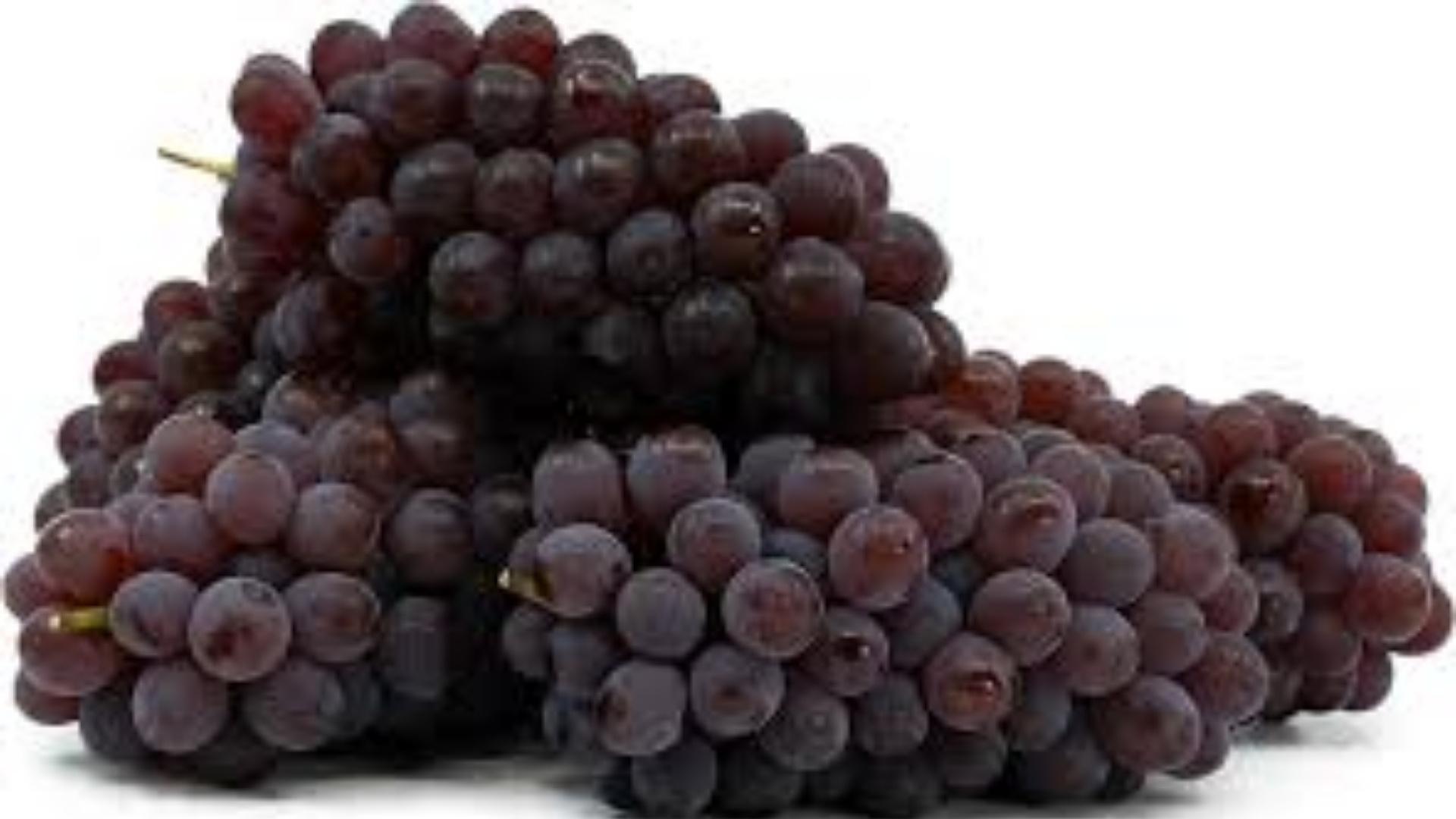
Small and flavorful, these grapes have a reddish-purple skin and sweet, juicy flesh. They are often eaten fresh or used to make wine and juice.
- Place of Origin: United States (Delaware region)
- Scientific Name: Vitis labrusca × Vitis vinifera hybrid
- Famous Alternative Names: Delaware Table Grape
Nutritional Content per 100 grams:
| Nutrient | Columns |
|---|---|
| Calories | 69 |
| Fat | 0.2 g |
| Carbohydrates | 18.0 g |
| Protein | 0.7 g |
| Fibre | 1.0 g |
Health Benefits:
- Provides natural sugars for energy
- Contains antioxidants that support cell health
- Supports hydration with high water content
- Easily digested and enjoyed fresh or processed
25. Dacryodes Fruit
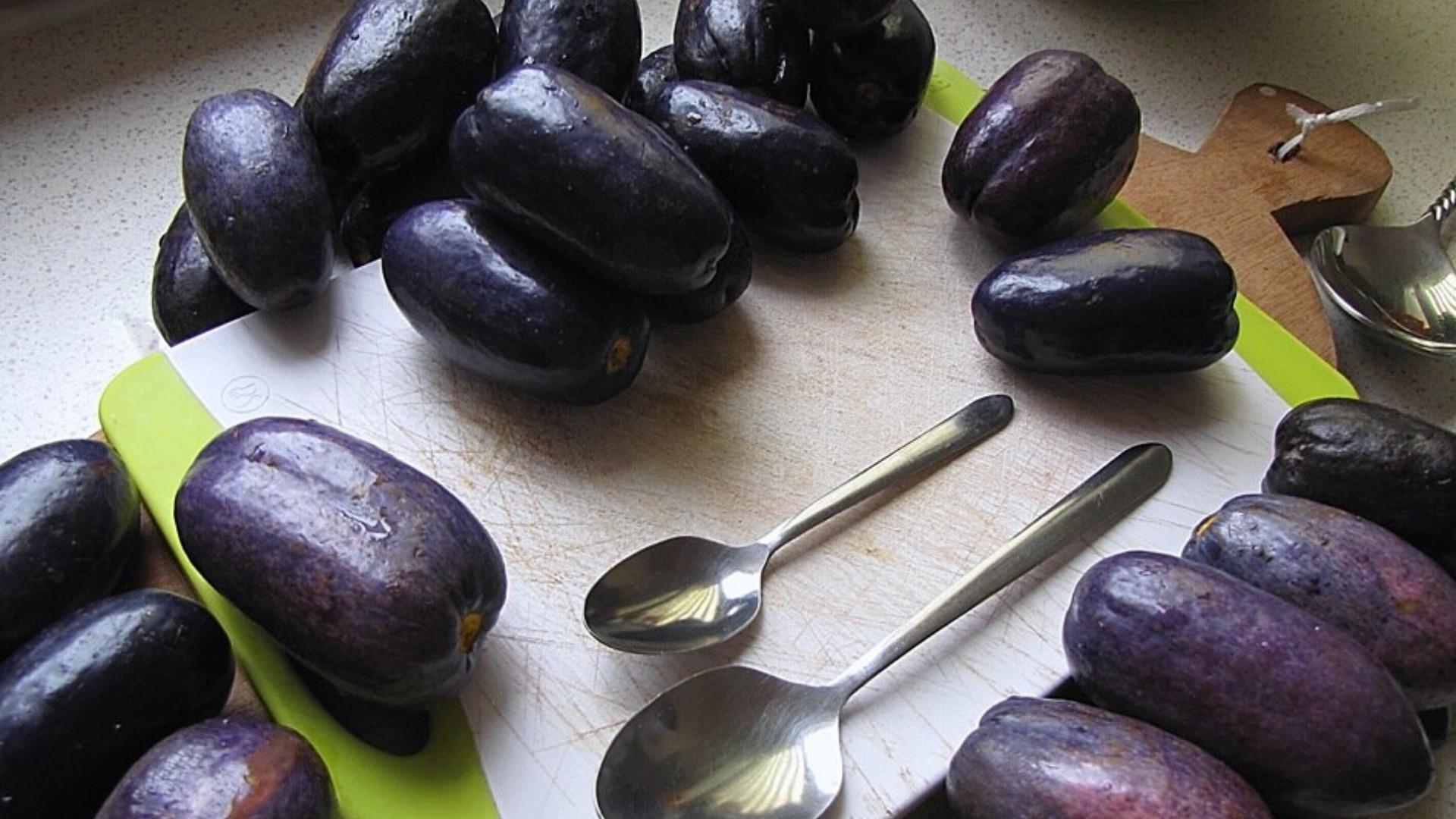
Recognized by its bluish-purple waxy skin and firm texture, this fruit softens when cooked and is often consumed alongside staple meals for its buttery flavor.
- Place of Origin: Central and West Africa
- Scientific Name: Dacryodes edulis
- Famous Alternative Names: African Safou, Butterfruit
Nutritional Content per 100 grams:
| Nutrient | Amount |
|---|---|
| Calories | 150 |
| Fat | 12.0 g |
| Carbohydrates | 10.0 g |
| Protein | 2.0 g |
| Fibre | 3.5 g |
Health Benefits:
- Provides essential fatty acids
- Aids digestion with dietary fibre
- Supports skin and cell health
- Nutrient-dense energy source
26. Delbard Jubilée Apple
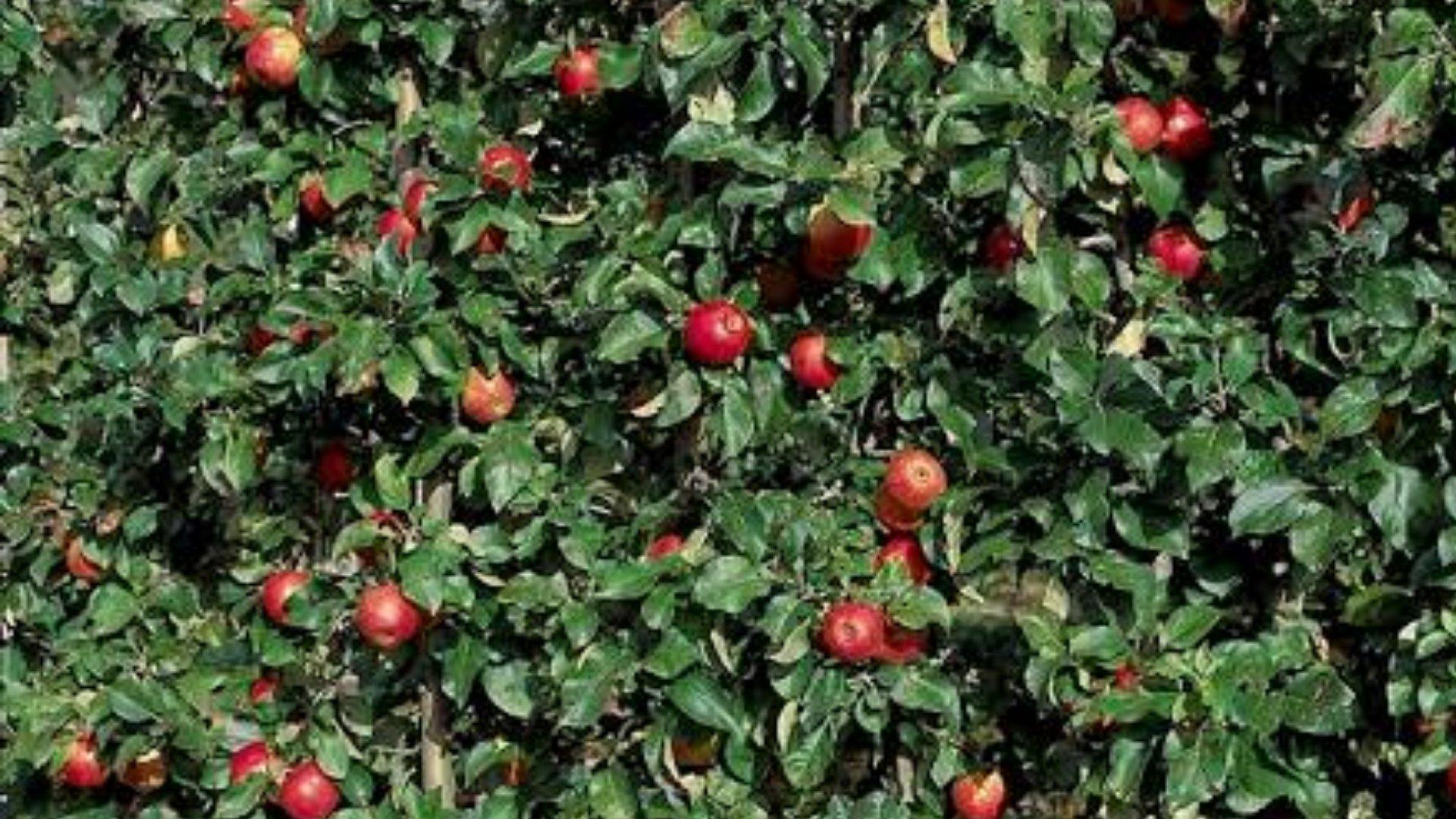
This crisp, yellow-skinned apple with a subtle red blush is valued for its juicy, sweet-tart flavor. It is widely used for fresh eating and baking.
- Place of Origin: France
- Scientific Name: Malus domestica ‘Delbard Jubilée’
- Famous Alternative Names: Delbard Jubilee
Nutritional Content per 100 grams:
| Nutrient | Amount |
|---|---|
| Calories | 52 |
| Fat | 0.2 g |
| Carbohydrates | 14.0 g |
| Protein | 0.3 g |
| Fibre | 2.4 g |
Health Benefits:
- Rich in fibre to aid digestion
- Provides natural sugars for sustained energy
- Contains vitamins important for immune health
- Low in fat, suitable for weight management
27. Dakota Grape

Compact and frost-resistant, these small, dark grapes have a sweet yet tart flavor and are often used in cold-climate winemaking or fresh consumption.
- Place of Origin: United States (Dakotas)
- Scientific Name: Vitis riparia × Vitis labrusca hybrid
- Famous Alternative Names: Northern Wild Grape
Nutritional Content per 100 grams:
| Nutrient | Columns |
|---|---|
| Calories | 69 |
| Fat | 0.2 g |
| Carbohydrates | 17.0 g |
| Protein | 0.6 g |
| Fibre | 1.4 g |
Health Benefits:
- Supports hydration through natural sugars
- Includes polyphenols beneficial for heart health
- Contributes to daily energy needs
- Easy to include in juices and salad bowls
28. Dalit Fruit
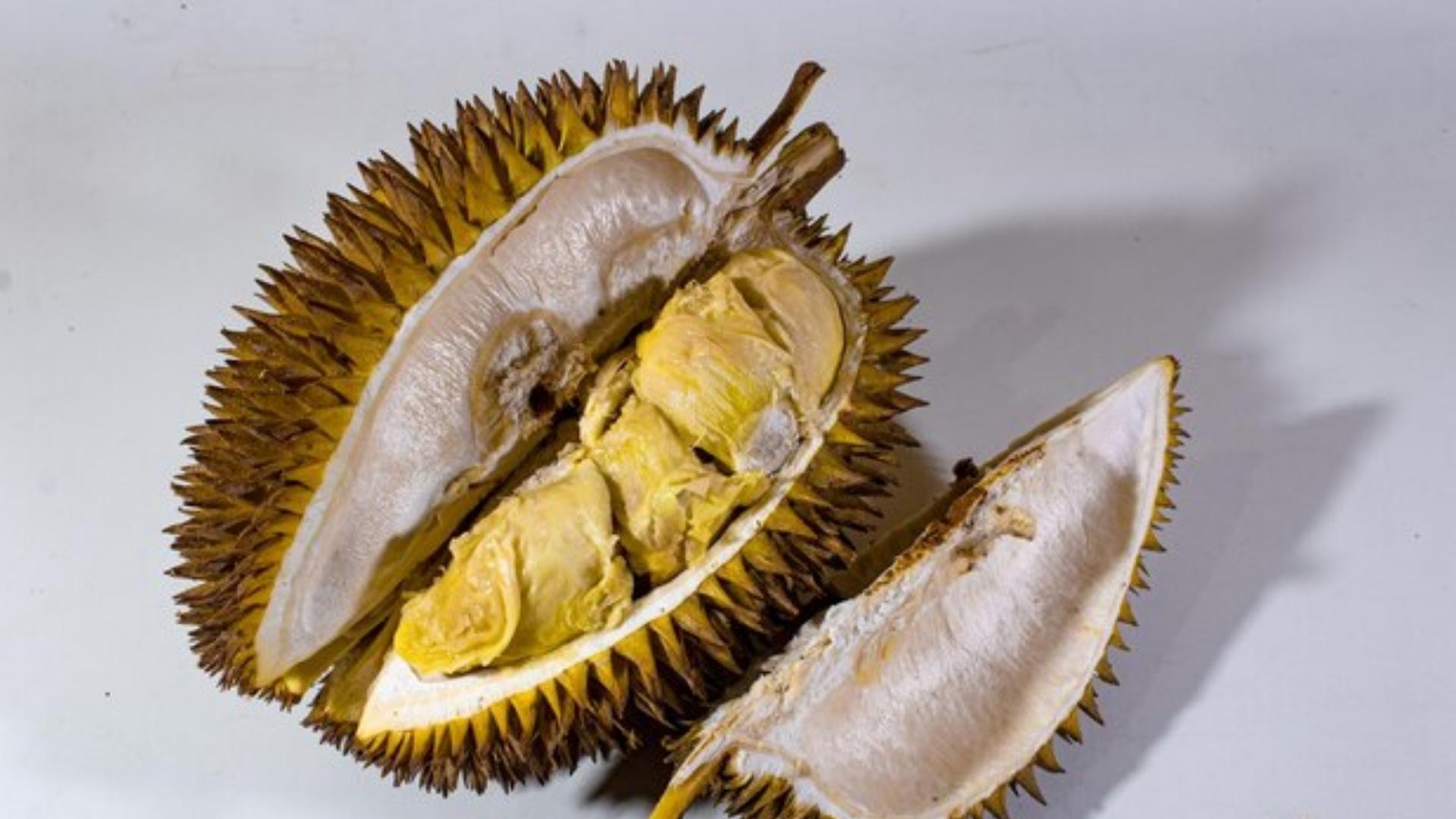
This prickly-skinned tropical berry is loved for its juicy pulp, often extracted for fresh juice or fermented into traditional Filipino beverages.
- Place of Origin: Philippines
- Scientific Name: Dillenia philippinensis
- Famous Alternative Names: Katmon Fruit
Nutritional Content per 100 grams:
| Nutrient | Columns |
|---|---|
| Calories | 55 |
| Fat | 0.3 g |
| Carbohydrates | 13.0 g |
| Protein | 1.1 g |
| Fibre | 2.0 g |
Health Benefits:
- Naturally refreshing due to water-rich pulp
- Assists digestion with moderate fibre
- Great in sour-flavored local recipes
- Low-calorie and tangy addition to drinks
29. Dalrymple Apple
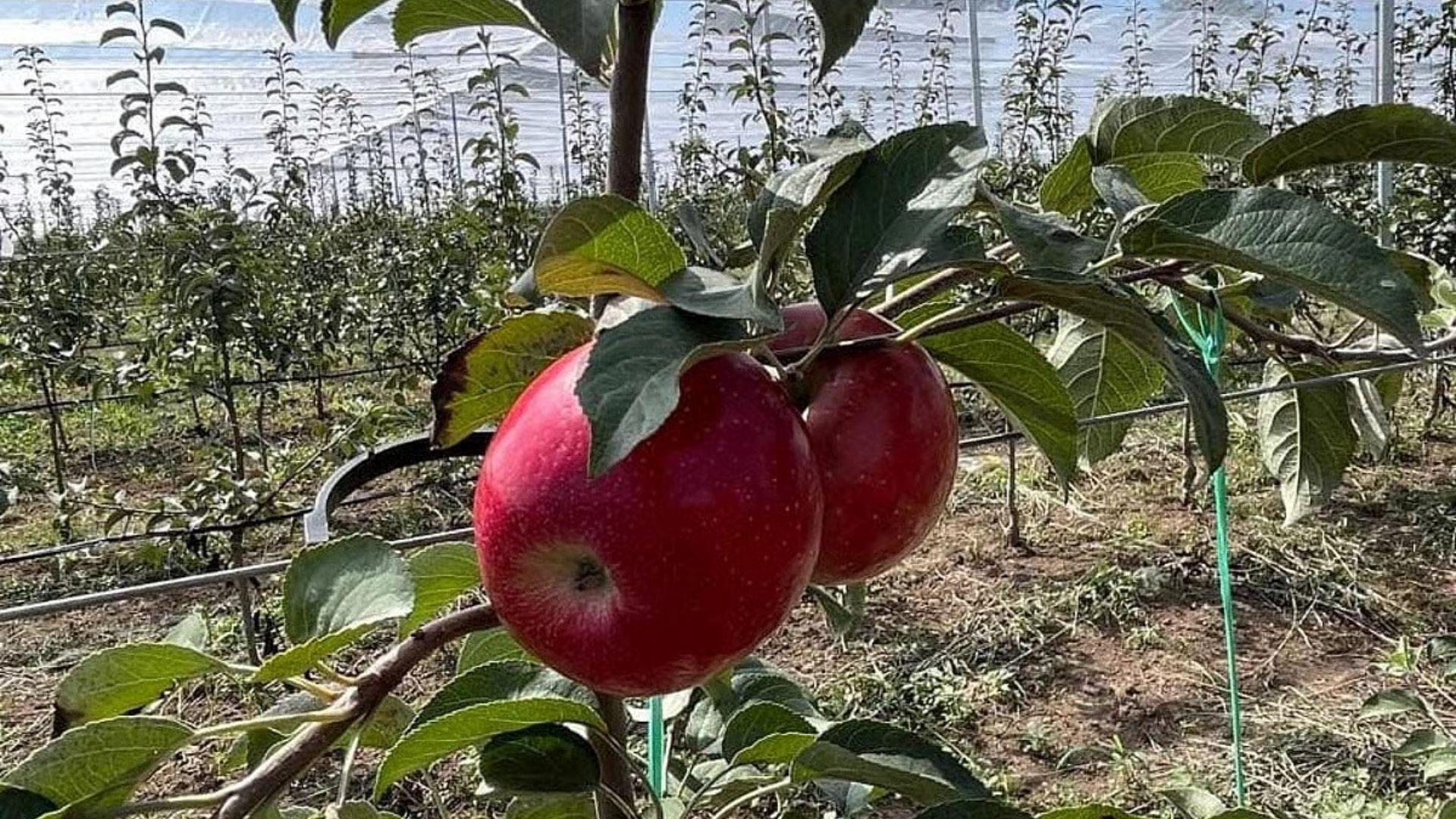
Characterized by its firm yellow skin with reddish streaks, this apple is crunchy with a mildly tart flavor and is ideal for fresh eating or salads.
- Place of Origin: United Kingdom
- Scientific Name: Malus domestica ‘Dalrymple’
- Famous Alternative Names: Dalrymple Dessert Apple
Nutritional Content per 100 grams:
| Nutrient | Columns |
|---|---|
| Calories | 52 |
| Fat | 0.2 g |
| Carbohydrates | 13.8 g |
| Protein | 0.3 g |
| Fibre | 2.4 g |
Health Benefits:
- Contributes to daily fibre intake
- Provides energy through natural sugars
- Suitable for low-fat diets
- Easy to incorporate into snacks and baked goods
30. Damara Plum

Small and reddish-purple, this native fruit is harvested from semi-desert regions and is known for its tart, plum-like flavor that works well in jam and jelly production.
- Place of Origin: Namibia
- Scientific Name: Berchemia discolor
- Famous Alternative Names: Bird Plum, African Plum
Nutritional Content per 100 grams:
| Nutrient | Columns |
|---|---|
| Calories | 60 |
| Fat | 0.4 g |
| Carbohydrates | 15.0 g |
| Protein | 0.9 g |
| Fibre | 2.3 g |
Health Benefits:
- Provides dietary fibre from wild fruit sources
- Naturally sweet and energy-boosting
- Often included in traditional preserves
- A wild-foraged source of micronutrients
31. Damietta Olive
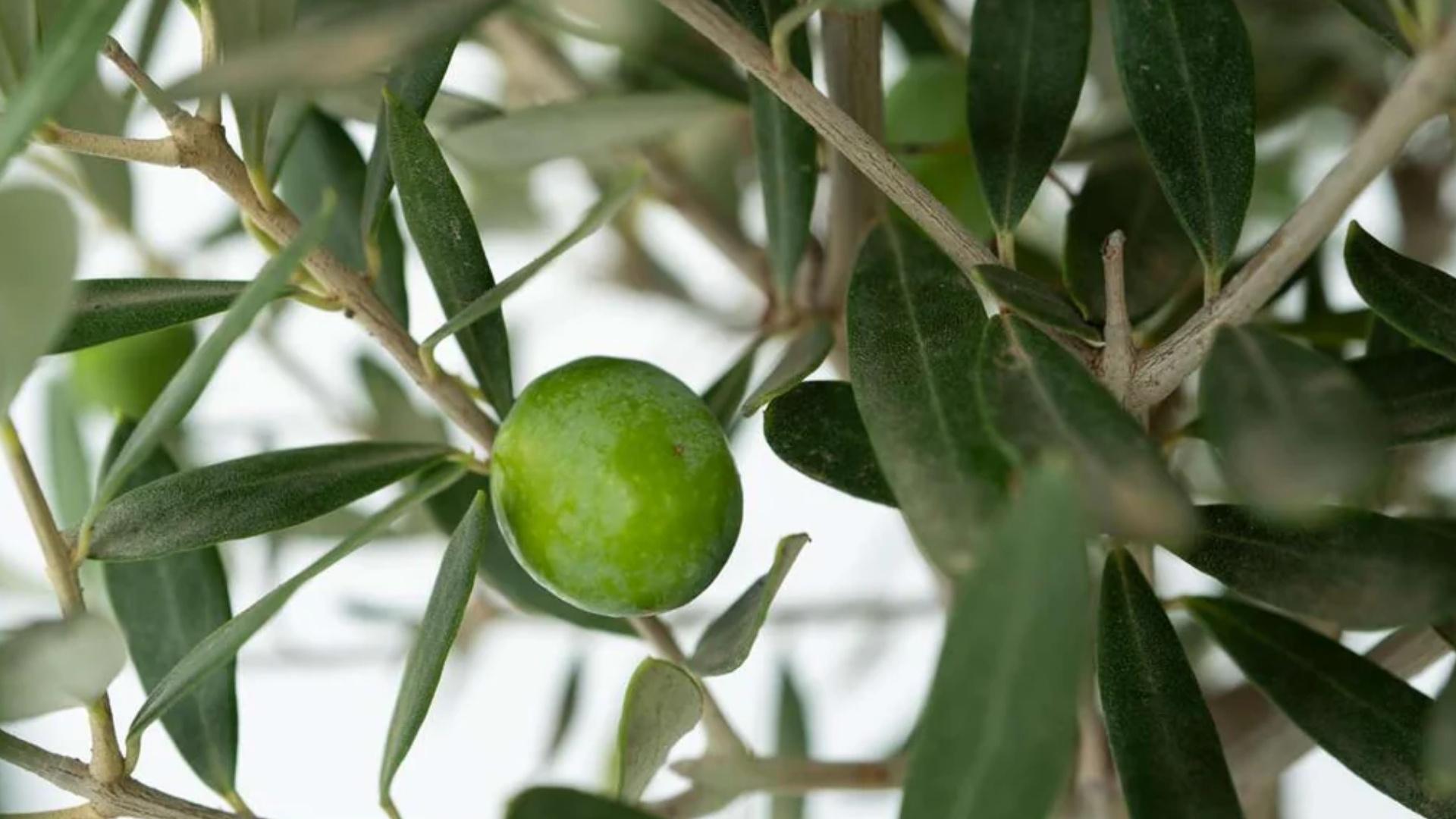
These medium-sized green to black olives are best known for their smooth texture and balanced flavor, making them a favorite in pickles, oil, and tapenade.
- Place of Origin: Egypt
- Scientific Name: Olea europaea ‘Damietta’
- Famous Alternative Names: Egyptian Table Olive
Nutritional Content per 100 grams:
| Nutrient | Columns |
|---|---|
| Calories | 115 |
| Fat | 10.7 g |
| Carbohydrates | 6.0 g |
| Protein | 0.8 g |
| Fibre | 3.0 g |
Health Benefits:
- High in natural healthy fats
- Offers fibre for gut support
- Can be preserved easily in brine or oil
- Complements salads and savory meals
32. Dambun Mango

This small and fibrous mango has a bright yellow rind and sharp aroma, commonly used to make chutneys and dried snacks in Northern Nigeria.
- Place of Origin: Nigeria
- Scientific Name: Mangifera indica (local cultivar)
- Famous Alternative Names: Hausa Mango
Nutritional Content per 100 grams:
| Nutrient | Columns |
|---|---|
| Calories | 65 |
| Fat | 0.3 g |
| Carbohydrates | 17.0 g |
| Protein | 0.6 g |
| Fibre | 1.8 g |
Health Benefits:
- Naturally sweet and refreshing
- Low-fat tropical fruit source
- Used in chutney and spicy sauces
- Great as a dried snack or pulp base
33. Danube Cherry
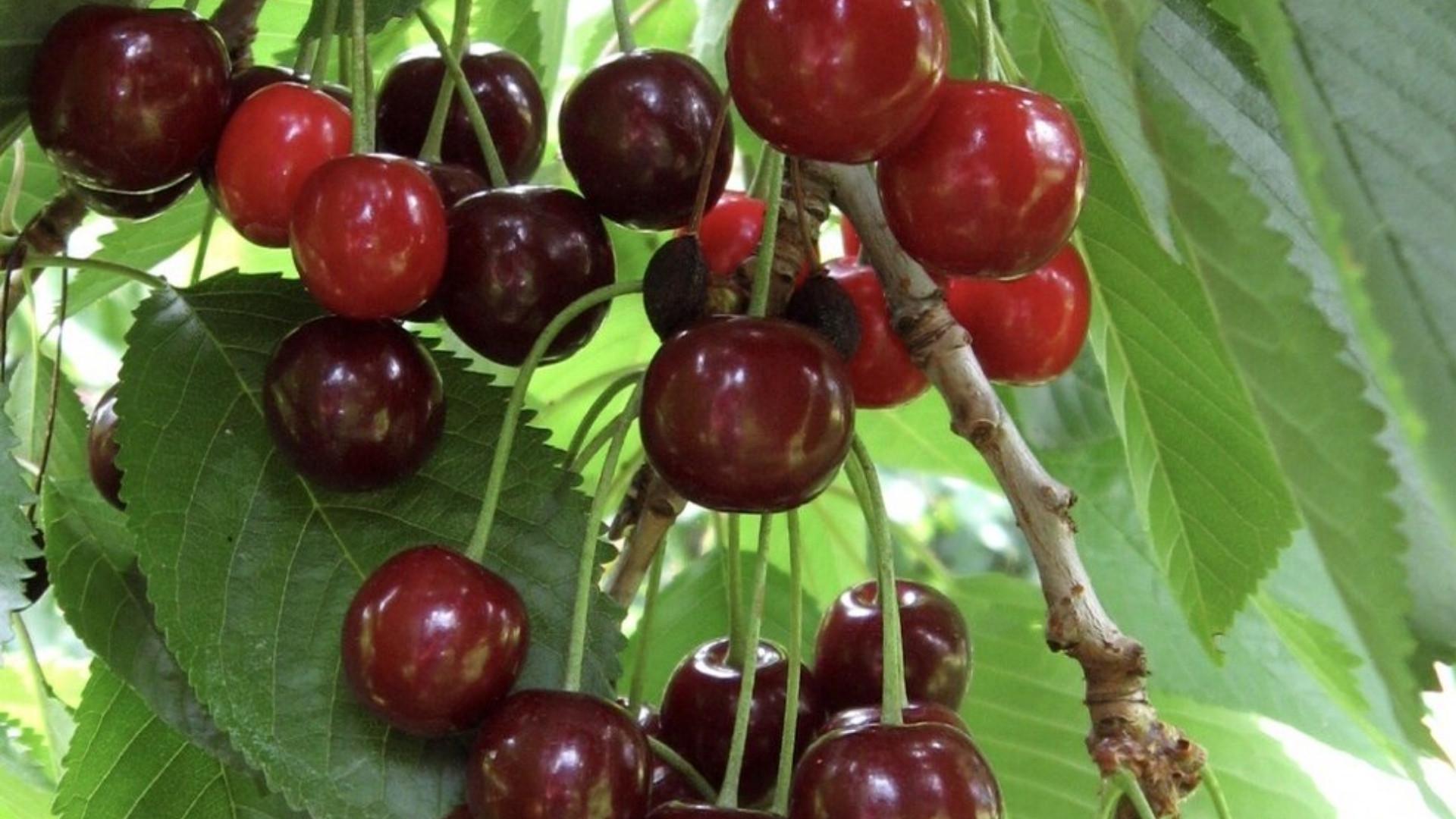
These dark, juicy cherries are prized in Eastern Europe for their sweet-tart balance and deep pigment, often used in liqueurs, jams, and chocolate pairings.
- Place of Origin: Hungary/Balkan region
- Scientific Name: Prunus cerasus ‘Danube’
- Famous Alternative Names: Erdi Bötermö, Hungarian Cherry
Nutritional Content per 100 grams:
| Nutrient | Columns |
|---|---|
| Calories | 63 |
| Fat | 0.4 g |
| Carbohydrates | 16.0 g |
| Protein | 1.2 g |
| Fibre | 2.4 g |
Health Benefits:
- Adds natural pigmentation and depth to desserts
- Excellent as a topping for tarts and cakes
- Good water content makes it refreshing in warm weather
- Easy to preserve or dry
34. Danta Fruit

Covered in a rough, woody casing, the juicy interior is enjoyed fresh or turned into local wines in forest communities across Africa.
- Place of Origin: Sub-Saharan Africa
- Scientific Name: Dialium guineense
- Famous Alternative Names: Velvet Tamarind
Nutritional Content per 100 grams:
| Nutrient | Columns |
|---|---|
| Calories | 64 |
| Fat | 0.5 g |
| Carbohydrates | 14.8 g |
| Protein | 1.9 g |
| Fibre | 3.1 g |
Health Benefits:
- Naturally sour-sweet taste adds flavor to drinks
- Popular in local snacks and candies
- Protein-rich compared to many fruits
- Long shelf life when dried or powdered
35. Dapple Dandy Plumcot
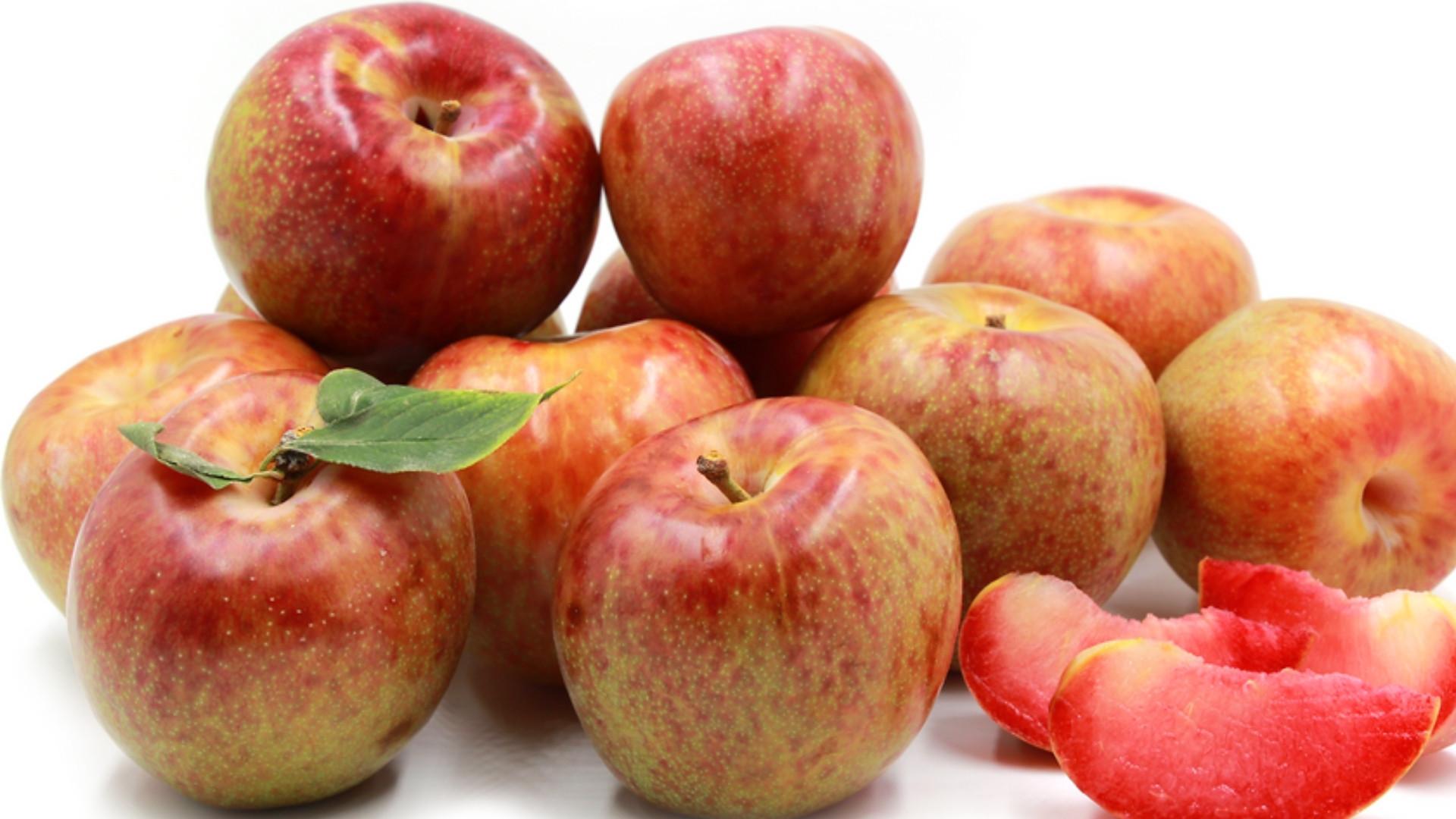
With a mottled pinkish-red skin and golden flesh, this hybrid fruit blends the flavors of plums and apricots. It’s juicy, sweet, and popular in summer fruit salads.
- Place of Origin: United States
- Scientific Name: Prunus salicina × Prunus armeniaca
- Famous Alternative Names: Dinosaur Egg, Plum-Apricot Hybrid
Nutritional Content per 100 grams:
| Nutrient | Columns |
|---|---|
| Calories | 70 |
| Fat | 0.2 g |
| Carbohydrates | 17.0 g |
| Protein | 0.8 g |
| Fibre | 2.2 g |
Health Benefits:
- Offers a refreshing combination of sweet and tangy flavors
- Easily included in smoothies, tarts, and snacks
- Helps with hydration due to high water content
- Rich color and layered taste profile enhance plates visually and nutritionally
36. Dapple Supreme Plum
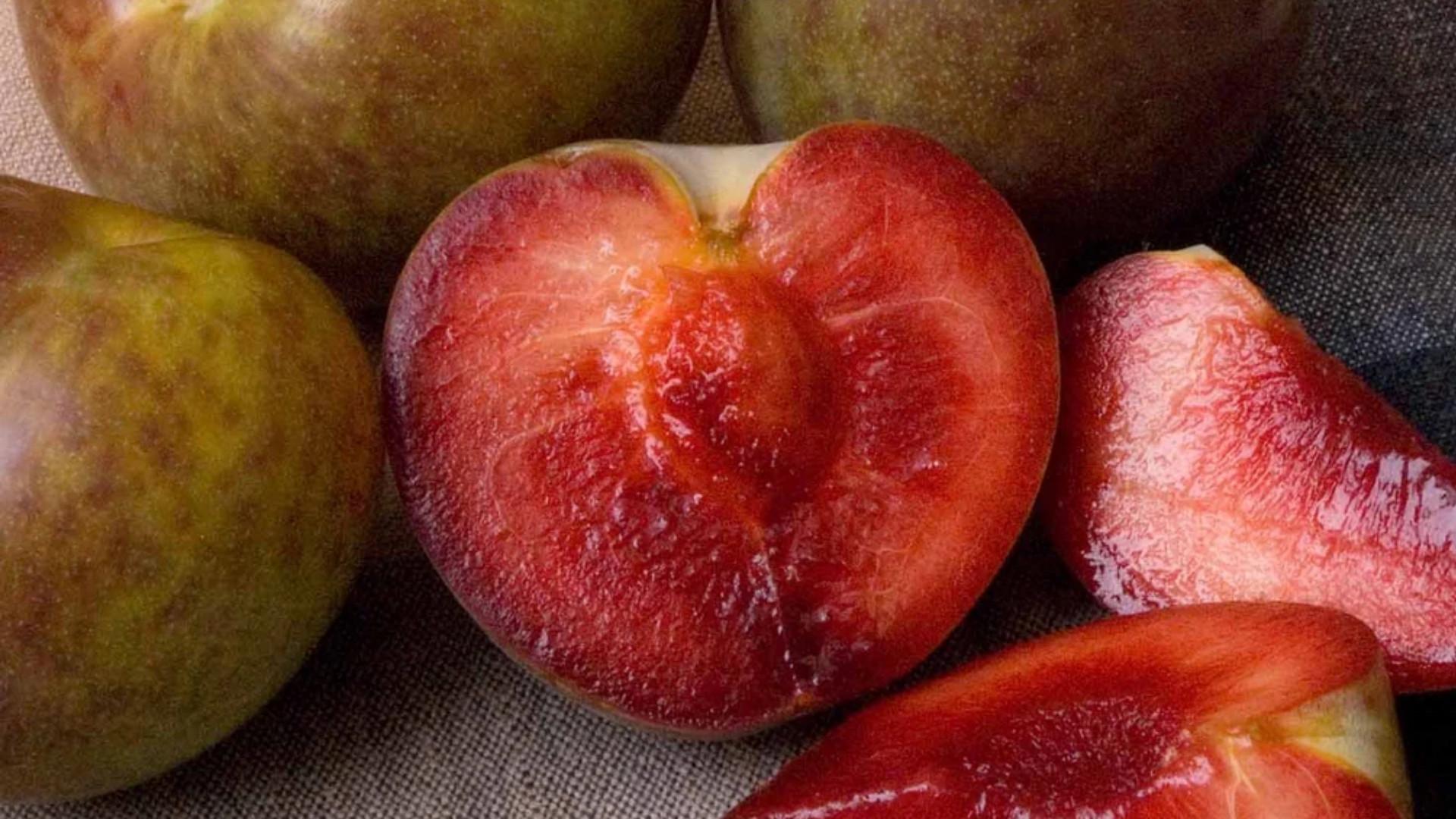
Smooth-skinned with a vivid bicolor coating, this stone fruit has dense, amber-toned flesh and is especially popular for its dessert-like sweetness.
- Place of Origin: United States
- Scientific Name: Prunus salicina (cultivar)
- Famous Alternative Names: Supreme Plum, Dapple Plum
Nutritional Content per 100 grams:
| Nutrient | Columns |
|---|---|
| Calories | 67 |
| Fat | 0.1 g |
| Carbohydrates | 16.5 g |
| Protein | 0.6 g |
| Fibre | 2.1 g |
Health Benefits:
- Delivers natural sweetness for healthier desserts
- Easy to digest
- Excellent as a quick energy snack
- Adds color and richness without added sugar
37. Dapple Sweet Aprium

Combining the sugary richness of apricots and the juiciness of plums, this hybrid fruit features soft, gold-tinged orange skin and a complex flavor.
- Place of Origin: United States
- Scientific Name: Prunus armeniaca × Prunus salicina
- Famous Alternative Names: Sweetcot, Apricot-Plum Hybrid
Nutritional Content per 100 grams:
| Nutrient | Columns |
|---|---|
| Calories | 65 |
| Fat | 0.2 g |
| Carbohydrates | 15.8 g |
| Protein | 0.9 g |
| Fibre | 2.6 g |
Health Benefits:
- Works well in pies, sauces, and compotes
- Adds a unique texture combination of firmness and softness
- Great for snacking on the go
- Mild tartness complements sweet dishes
38. Darling Apple
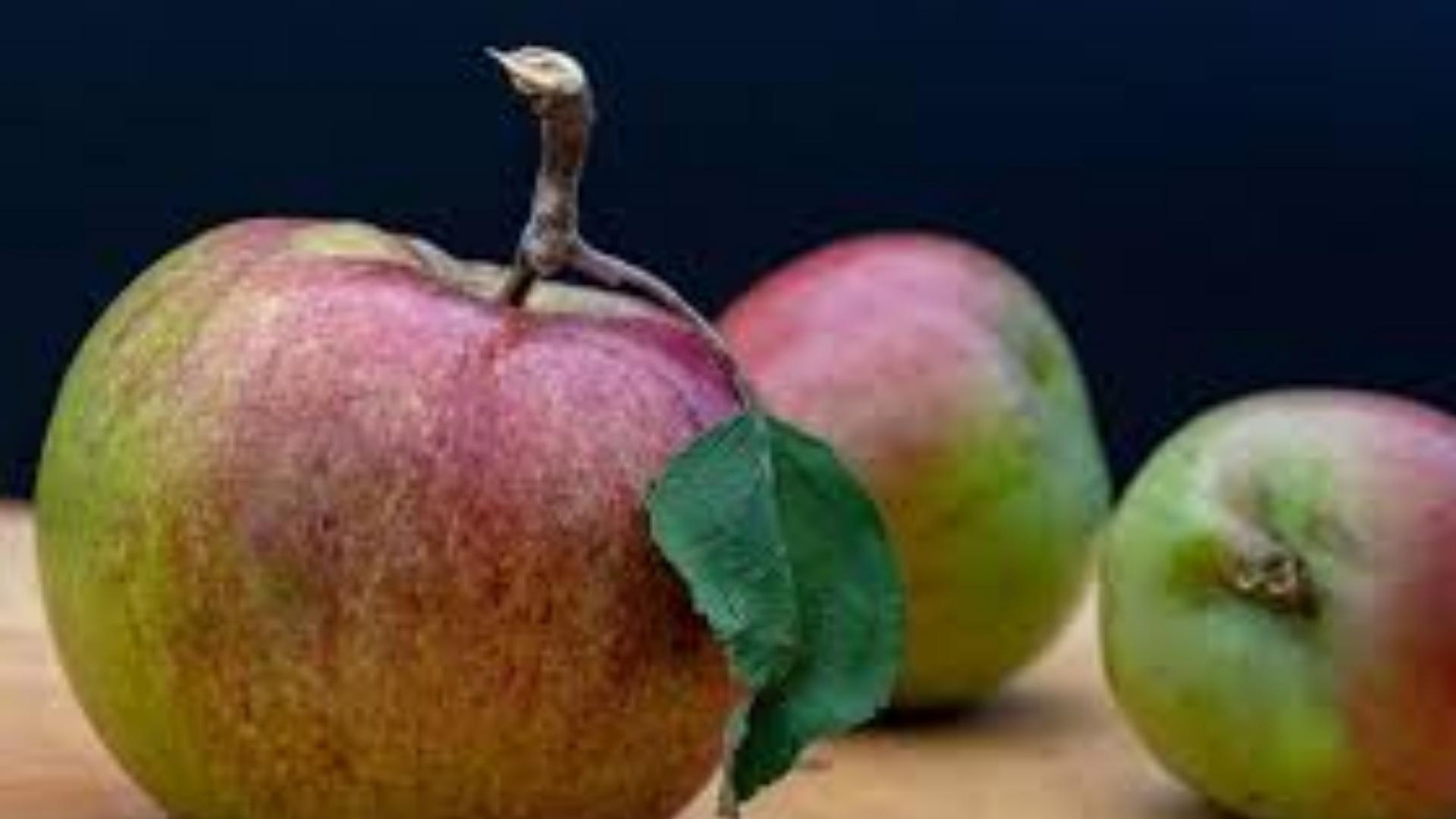
Known for its rosy-red hues and crisp crunch, this apple cultivar is prized for its balanced flavor, mildly sweet with a light floral finish.
- Place of Origin: United States
- Scientific Name: Malus domestica ‘Darling’
- Famous Alternative Names: Red Darling Apple
Nutritional Content per 100 grams:
| Nutrient | Columns |
|---|---|
| Calories | 52 |
| Fat | 0.1 g |
| Carbohydrates | 13.5 g |
| Protein | 0.3 g |
| Fibre | 2.2 g |
Health Benefits:
- Crunchy texture improves satiety
- Great for both raw eating and light baking
- Natural sweetness is useful for reducing added sugars
- Pairs well in cheese boards and fruit mixes
39. Darwin’s Vine Fruit
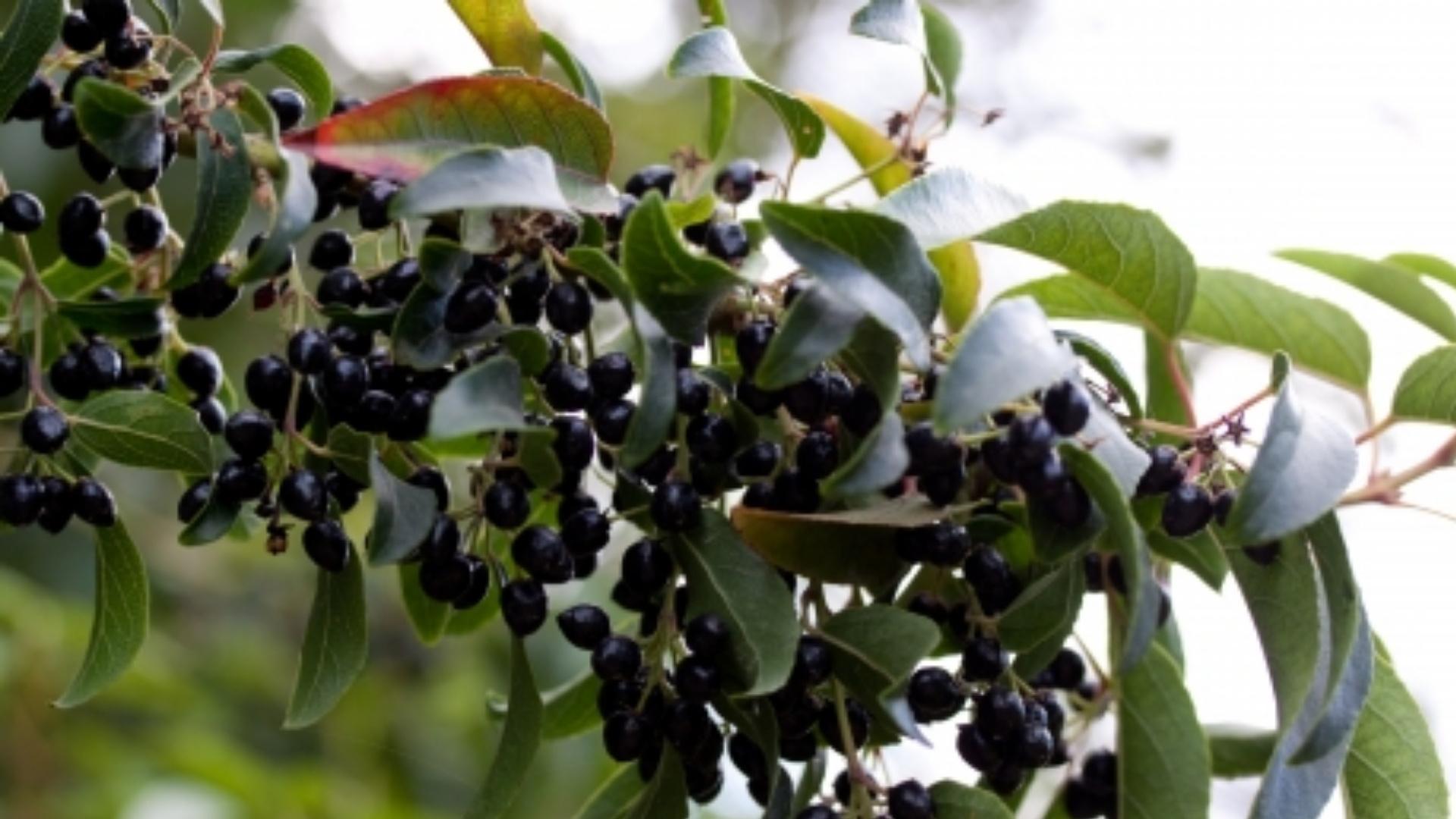
These small berries grow on a hardy Andean vine, producing clusters of dark blue-purple fruits that are often turned into jams or fermented drinks.
- Place of Origin: South America (Andean mountains)
- Scientific Name: Aristotelia chilensis or related genus
- Famous Alternative Names: Chilean Grape, Darwin’s Fruit
Nutritional Content per 100 grams:
| Nutrient | Columns |
|---|---|
| Calories | 60 |
| Fat | 0.2 g |
| Carbohydrates | 15.0 g |
| Protein | 0.5 g |
| Fibre | 2.0 g |
Health Benefits:
- Used in fermentable fruit drinks and syrups
- Adds rich color to beverages and dishes
- Sizable skin-to-flesh ratio boosts texture in preserves
- Appeals to foragers and natural product enthusiasts
40. Delizia Apple

Delizia Apple is known for its bright red skin and crisp texture, delivering a juicy, sweet taste. Popular for fresh eating and baking.
- Place of Origin: Italy
- Scientific Name: Malus domestica ‘Delizia’
- Famous Alternative Names: Red Delizia
Nutritional Content per 100 grams:
| Nutrient | Amount |
|---|---|
| Calories | 53 |
| Fat | 0.2 g |
| Carbohydrates | 13.8 g |
| Protein | 0.3 g |
| Fibre | 2.3 g |
Health Benefits:
- High in dietary fiber, supporting digestion
- Provides natural, low-fat energy
- Rich in antioxidants and vitamins
- Crisp texture is ideal for snacks and desserts
41. Dead Sea Apple
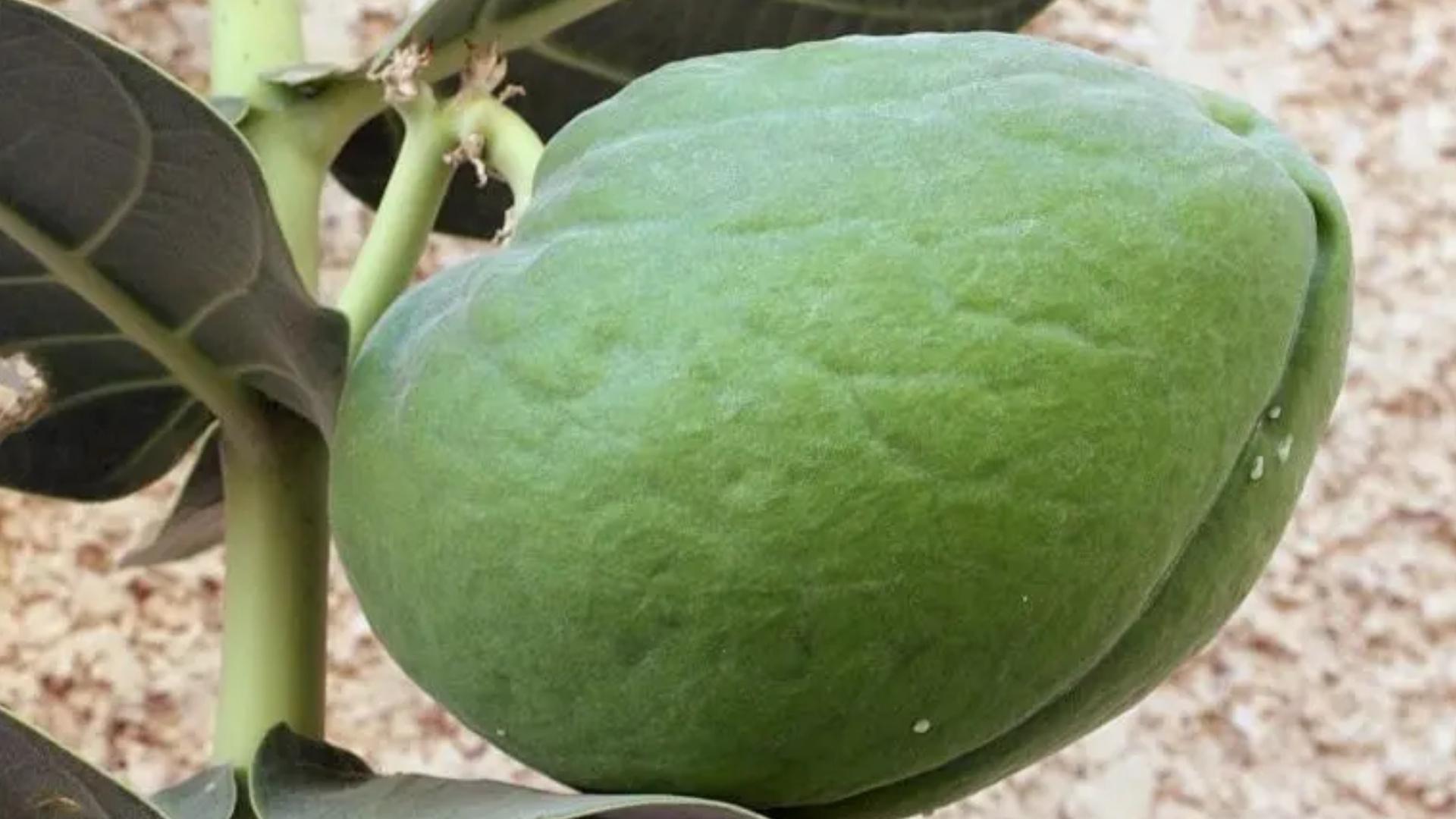
This large, green, melon-like fruit appears waxy or shiny and is used in processed sauces and local condiments after careful preparation.
Note: This fruit can not be eaten raw; only some parts are edible.
- Place of Origin: Middle East
- Scientific Name: Calotropis procera (processed form only)
- Famous Alternative Names: Sodom Apple
Nutritional Content per 100 grams (edible processed parts):
| Nutrient | Columns |
|---|---|
| Calories | 50 |
| Fat | 0.2 g |
| Carbohydrates | 13.0 g |
| Protein | 0.6 g |
| Fibre | 2.5 g |
Health Benefits:
- Needs special preparation to remove bitterness
- Used in indigenous flavoring pastes
- Has culinary heritage in desert regions
- Rare and very environmentally specific fruit
42. Dealate Fig
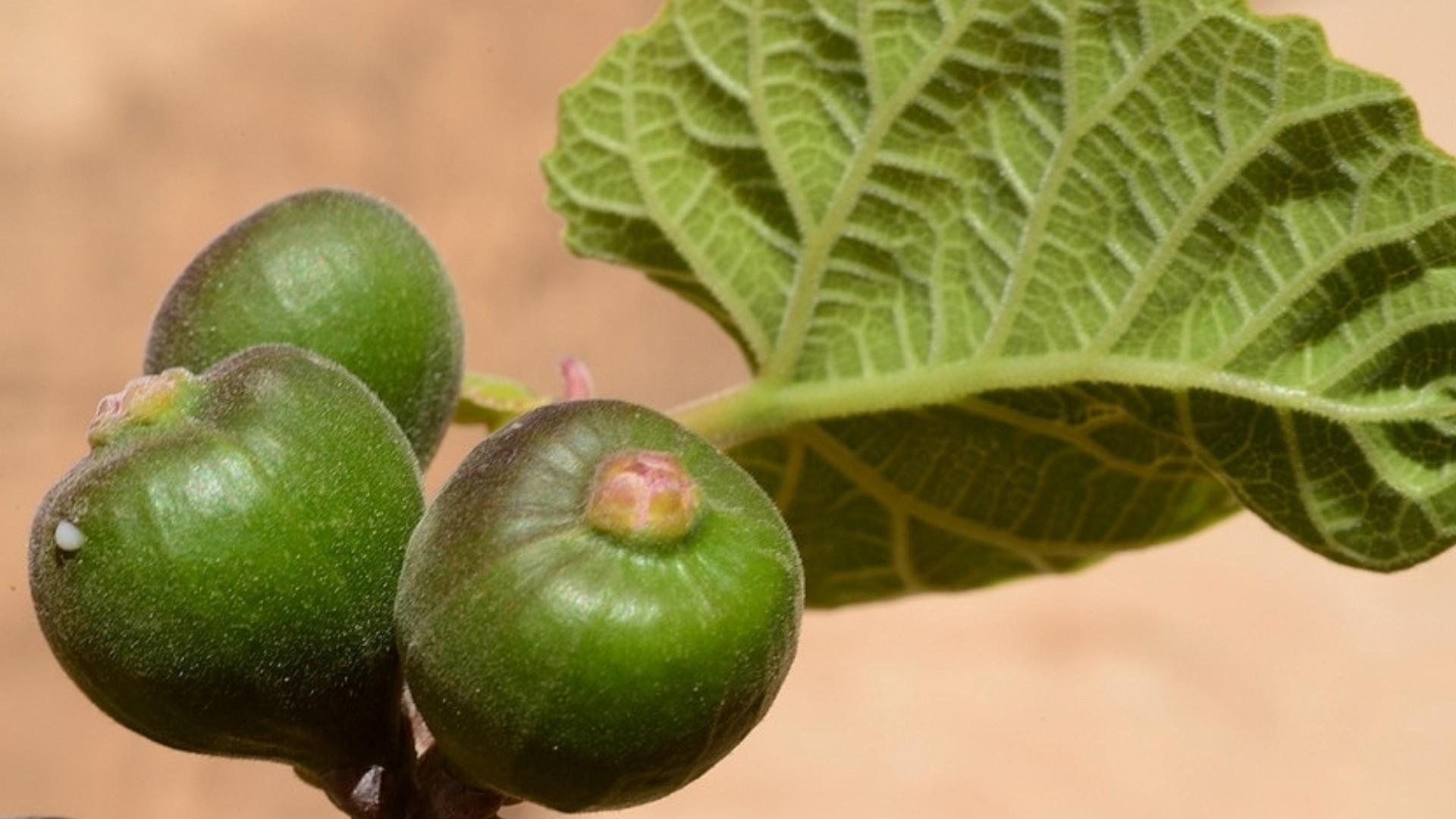
Typically small and seed-rich, this fig species thrives in arid ecosystems and is picked late in its season for its honeyed pulp.
- Place of Origin: North Africa
- Scientific Name: Ficus palmata
- Famous Alternative Names: Wild Desert Fig
Nutritional Content per 100 grams:
| Nutrient | Columns |
|---|---|
| Calories | 74 |
| Fat | 0.4 g |
| Carbohydrates | 19.0 g |
| Protein | 0.8 g |
| Fibre | 2.9 g |
Health Benefits:
- Adds sweetness to local breads and flatbreads
- Dense texture makes it good in preserves
- Often dried and stored for year-round use
- Easily eaten raw when fully ripe
43. Debut Apple
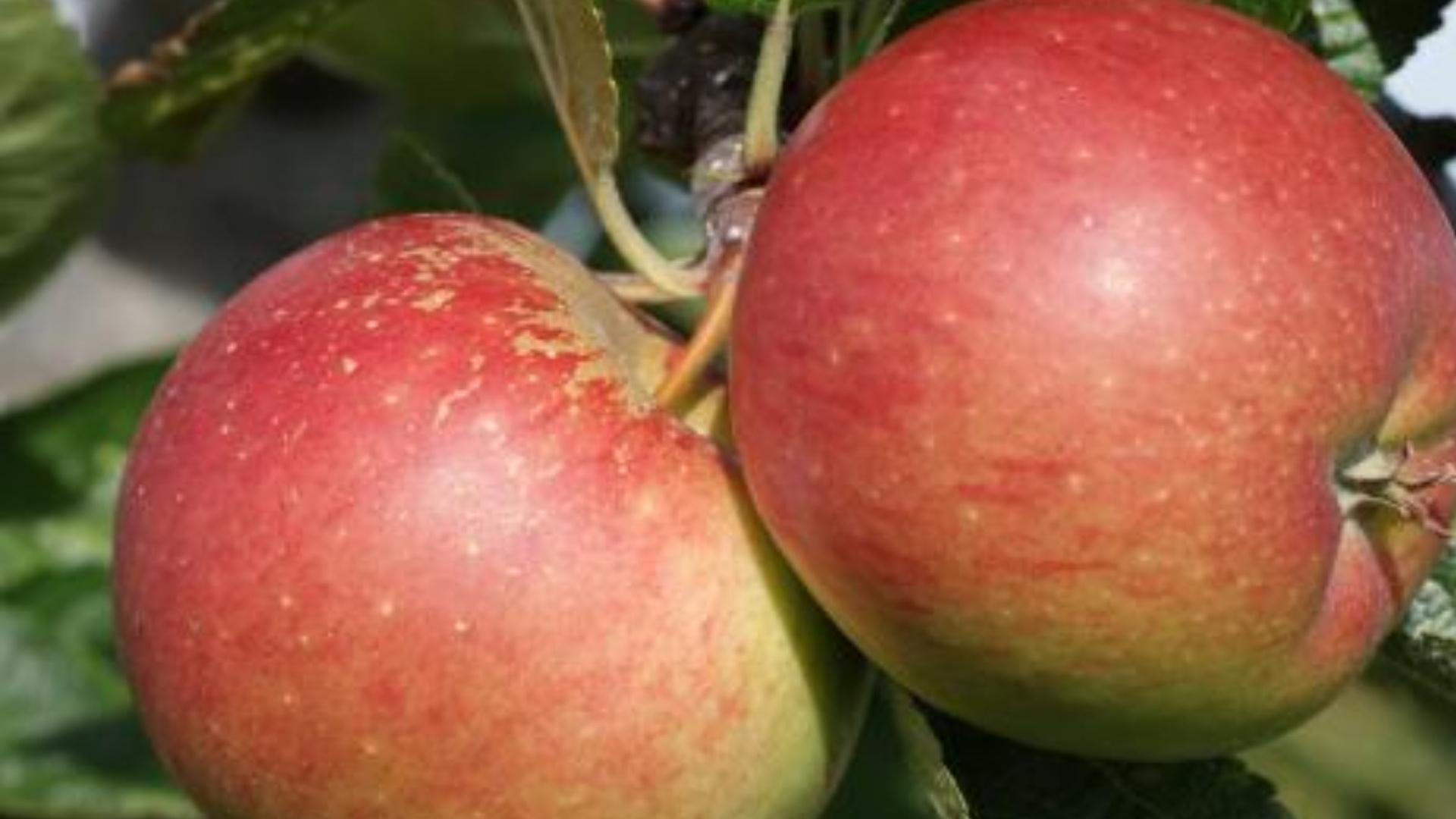
With a soft yellow-pink blush and mild flavor, this early-harvest apple is ideal for snacking and light baking due to its low acidity.
- Place of Origin: Canada
- Scientific Name: Malus domestica ‘Debut’
- Famous Alternative Names: Early Gold Apple
Nutritional Content per 100 grams:
| Nutrient | Columns |
|---|---|
| Calories | 49 |
| Fat | 0.1 g |
| Carbohydrates | 13.0 g |
| Protein | 0.4 g |
| Fibre | 2.3 g |
Health Benefits:
- Perfect for school snacks and packed lunches
- Balances sugar and tartness for a gentle flavor
- Light and hydrating
- Can be steamed or stewed for toddlers’ meals
44. Dedo De Dama Grape
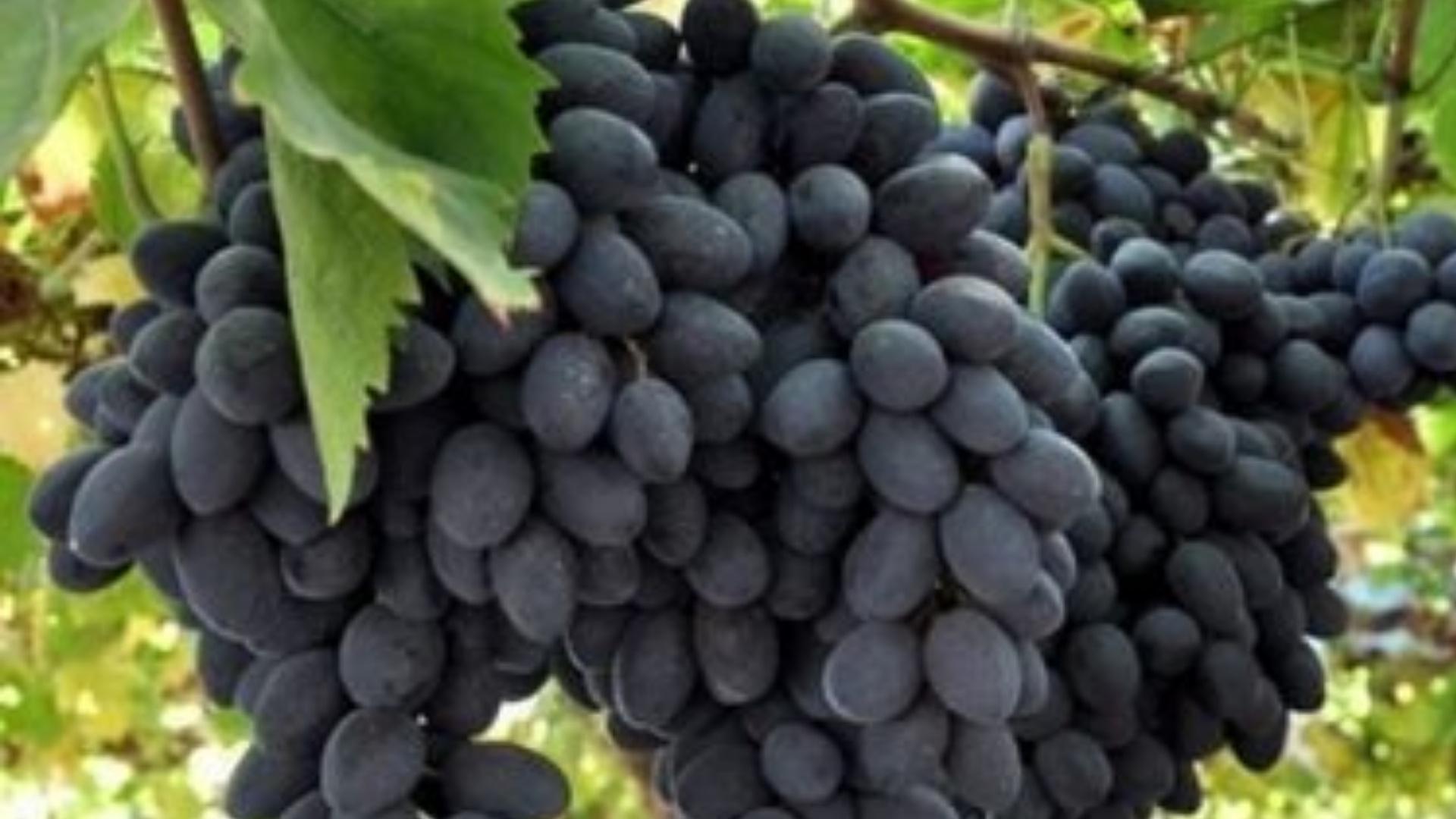
Elongated and slender, these finger-shaped grapes are seedless and juicy-sweet, commonly found at European fruit markets and known for high table-grape quality.
- Place of Origin: Spain
- Scientific Name: Vitis vinifera ‘Dedo de Dama’
- Famous Alternative Names: Lady’s Finger Grape
Nutritional Content per 100 grams:
| Nutrient | Columns |
|---|---|
| Calories | 69 |
| Fat | 0.2 g |
| Carbohydrates | 18.1 g |
| Protein | 0.6 g |
| Fibre | 1.2 g |
Health Benefits:
- Great for snacking and charcuterie boards
- Seedless and kid-friendly
- Easy addition to fruit skewers
- Popular in fruit arrangements and parfaits
45. Deep Scarlet Plum
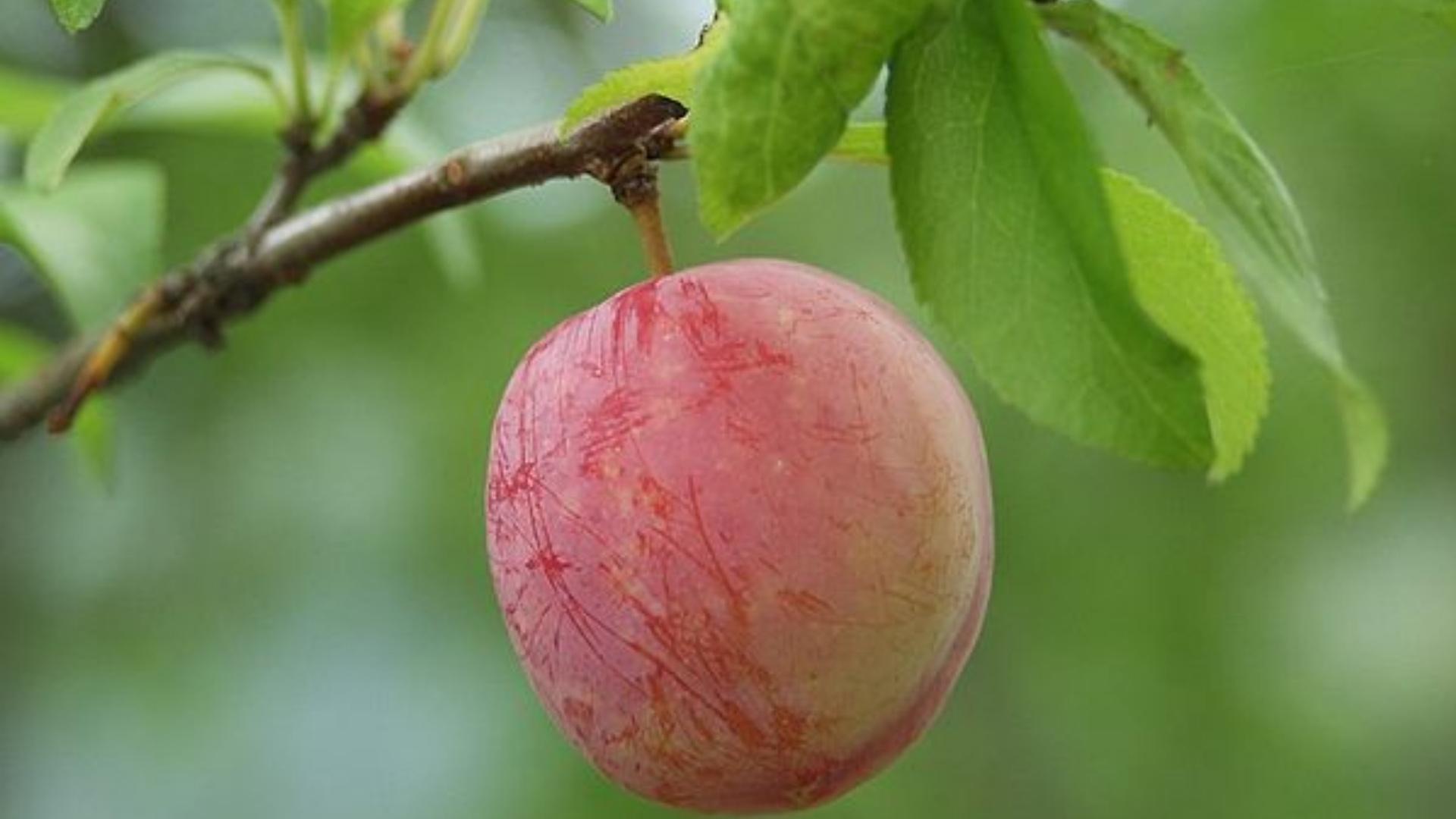
This Japanese plum variety stands out with intensely red skin and reddish-golden flesh, delivering a juicy, tangy-sweet punch when bitten into.
- Place of Origin: Japan
- Scientific Name: Prunus salicina ‘Deep Scarlet’
- Famous Alternative Names: Crimson Jewel Plum
Nutritional Content per 100 grams:
| Nutrient | Columns |
|---|---|
| Calories | 68 |
| Fat | 0.2 g |
| Carbohydrates | 15.5 g |
| Protein | 0.8 g |
| Fibre | 2.0 g |
Health Benefits:
- Intensely flavored for bold dessert applications
- Great for compotes and preserves
- Adds visual appeal to fruit tarts
- Useful in naturally tinted fruit juices
46. Deer Berry
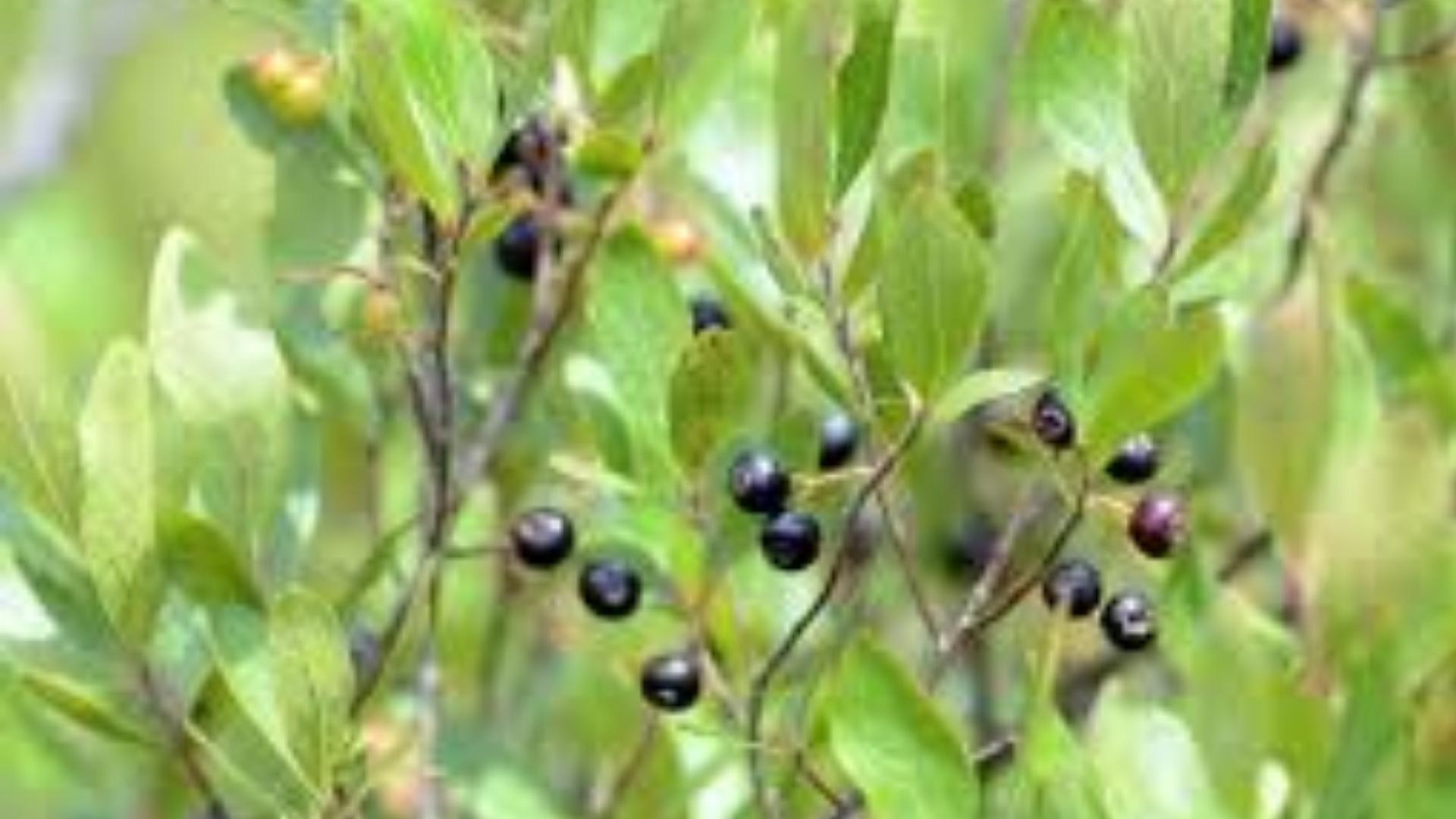
These blue-black berries grow in moist woods and sandy soils. Their mildly sweet flavor comes out best when cooked or sweetened, perfect for jams and traditional compotes.
- Place of Origin: Eastern North America
- Scientific Name: Gaylussacia baccata
- Famous Alternative Names: Black Huckleberry
Nutritional Content per 100 grams:
| Nutrient | Columns |
|---|---|
| Calories | 47 |
| Fat | 0.3 g |
| Carbohydrates | 11.2 g |
| Protein | 0.7 g |
| Fibre | 3.4 g |
Health Benefits:
- Excellent in pies, pancakes, and muffins
- Pleasant aroma when folded into syrup
- Works well in slow-cooked fruit sauces
- Blends easily with other forest berries
Wrapping It Up
From common dates to exotic dragon fruits, each option offers something special.
These fruits provide important vitamins, minerals, and health benefits for your body.
Learning about different fruits helps you make better food choices every day.
The letter “D” truly delivers more variety than most people ever imagine.
Some fruits are easy to find, while others require trips to specialty stores.
Each fruit has its own taste, texture, and cultural background worth learning about.
Trying new fruits can make your meals more interesting and nutritious.
Adding these fruits to your diet can improve your overall health significantly.
Exploring different fruit options keeps your eating habits from becoming boring or repetitive.
Which fruit you heard about today seemed most unique to you? Tell us in the comments below.






